You’d think plug-in hybrids would be an easy sell.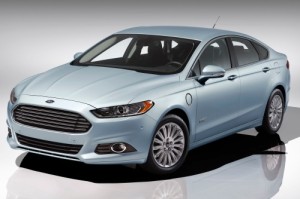
Unlike a regular hybrid, which has to burn gas at least some of the time to remain operational, a plug-in hybrid has the capability to burn no gas at all – and still get you from A to B. Instead of being plugged-in to ExxonMobil, you plug into a wall outlet at home (or work).
But while sales of regular hybrids have been strong, there’s only been tepid interest in the plug-in versions of popular hybrids like the Toyota Prius – which Toyota just announced it will be heavily discounting for the new model year. See here for more about that.
Ford’s Fusion Energi – the plug-in version of the Fusion hybrid – is doing better: So far this year (as of October, the latest date for which figures were available) about 4,500 of them have been sold – and Ford says sales are on the uptick.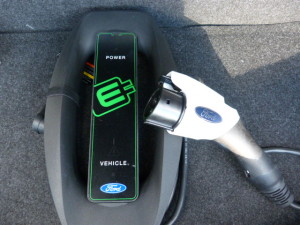
But it’s still a relative drop in the bucket.
How come?
I’ll give you my take on that now.
WHAT IT IS
The Fusion Energi is the plug-in version of the Ford Fusion hybrid. It has a more powerful lithium-ion battery pack and so can travel much farther (up to about 20 miles or so) and much faster (up to 85 MPH) on battery power alone – and can be recharged externally, by plugging the car into any household 120V outlet.
The regular Fusion hybrid can only creep along briefly (a mile or so, max) at relatively low speeds (about 25 MPH, max) on battery power alone – and can only recharge its batteries by recapturing energy from momentum during deceleration or coasting (regenerative braking) or by using its gasoline-burning engine as an onboard generator
Base price for the 2014 Fusion Energi is $38,700 – vs. $26,200 for the regular Fusion hybrid.
A top-of-the-line Energi Titanium lists for $40,500 – vs. $32,500 for the Titanium-trimmed version of the regular Fusion hybrid.
Some additional content has been added to the roster – including an available heated steering wheel.
And while Toyota has reduced the price of the plug-in Prius for 2014 (base MSRP now just under $30k) Ford has not increased the price tag of the Fusion Energi. The 2014’s base MSRP is the same as the base price of the 2013 model.
WHAT’S GOOD
A much sexier bitch than the Prius.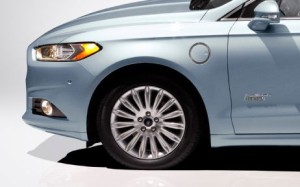
Faster on the batteries – and otherwise – than the Prius.
One of the best handling, most driver-pleasing hybrids out there.
Potential to save you a lot of money on gas.
Very roomy interior (roomier than Prius).
WHAT’S NOT SO GOOD
Significantly less fuel-efficient than the plug-in Prius.
Less fuel-efficient (IC engine running) than regular Fusion hybrid.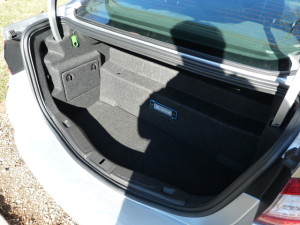
Massively more expensive than the Prius.
As expensive as a mid-level Lexus or BMW – but still a Ford.
Microscopic (8.2 cubic foot) trunk.
Spend a lot to buy it – may not save much driving it.
UNDER THE HOOD
The Fusion Energi has a more energetic hybrid powertrain than the standard Fusion hybrid. There’s the same 2.0 liter gas engine for the IC side of the system, but the Energi has a larger/higher-capacity lithium ion battery pack that enables it to operate in “EV” (electric vehicle) mode for longer – and to run at much higher speeds on volts alone.
The Energi’s battery pack can also be recharged externally – via a power cord that plugs into a special outlet on the driver’s side fender. The other end goes into either a standard 120V household oultet or (if you pay extra to have it rigged up) a 240 Volt outlet. It takes about 7 hours to recharge from dry using the 120V outlet – and between two and three hours using the 240V “fast charger.”
The combo’s total power output is 195 hp – enough to make the Energi perform like a veritable Hemi ‘Cuda . . .as plug-in hybrids go. Fully juiced – and using both the sizzle of the batteries and the combustive thrust of its IC engine – the Ford can get to 60 in just under eight seconds. For a hybrid, that is speedy.
The Prius plug-in (which maxxes out at 134 hp) is a Yugo in comparison.
A tired Yugo.
It needs 10 seconds to get to 60. And its top speed – given’ her all she’s got, cap’n – is around 115 (don’t ask how I know).
But, nothing’s free – and while the Prius is slow-pokey, it’s significantly more fuel-efficient: 51 city/49 highway vs. the Energi’s none-too-spectacular 44 city, 41 highway.
In fact, the Fusion Energi’s EPA numbers are lower than the standard Fusion hybrid’s numbers. The latter rates 47 city/47 highway – 6 MPG better on the highway than the Energi.
Now – theoretically – the Energi’s overall mileage (the average on the IC engine plus on the batteries, divided up) could be vastly better than the regular hybrid Fusion’s because of the Energi’s potential to get from A to B without burning any gas at all.
The issue is whether you’ll actually be able to do that in the course of your everyday driving – and if not, whether the regular Fusion hybrid (or the Prius plug-in) makes more economic sense.
Like the Plug-in Prius (and other plug-in hybrids) the Energi can trundle down the road on battery power alone for a considerable distance – as far as 21 miles. Which is farther than the plug-in Prius (15 miles). The Energi is also a lot faster on the batteries alone: 85 MPH vs. 60-ish in the Prius, before the system calls upon the IC engine for back-up.
But to get to the 21 mile mark on just the batteries, you’ll need to keep your speed well under 80.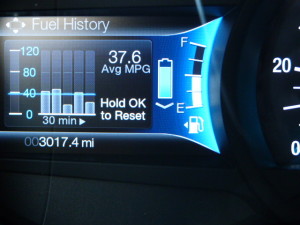
In fact – in my experience, test driving the Energi – sustained driving at highway speed (60 MPH and up) will deplete the lithium-ion battery pack’s charge in 10 miles or less. Once that happens, the system automatically defaults to mixed-mode operation (IC engine kicking in frequently to provide motive thrust as well as to provide juice to the batteries and electric motor) and your mileage may be not what you’d hoped. I averaged 37.6 MPG during the week I had the car – which is considerably less than I’ve averaged in the regular (non-plug-in) Prius, which almost always managed at least mid-40s, even if I deliberately tried my best to make the worst of the hybrid layout by constantly driving the thing at 70-plus and doing my best imitation of an Al Gore-endorsed bracket racer whenever the light went green.
It was almost impossible to get the Prius below 40 MPG, no matter how I drove it.
But I had trouble getting the Energi over 40 once the overnight charge had been depleted – and the IC engine had to pinch hit to keep the car going.
This is the price you pay for speediness (and quickness). Like the Tesla electric car, the Fusion Energi is about more than merely MPGs. It is capable of decent mileage – and excellent performance.
The Prius is capable of excellent mileage – but gives you more pedestrian performance. It is an appliance, basic transpo designed to get you there cheaply – not quickly.
The contrast between the Energi and the Prius plays out in the curves, too. There’s nil body roll and it’s fairly hard to even get the Ford’s tires to squeal – much less slide. This is no challenge at all in the Prius – but then, it’s handicapped as a planet-friendly autocrosser by its standard low-performance (but low rolling resistance) fifteen inch wheel/tire package. The Fusion comes standard with sportier seventeens. Still, even if you shod the Prius with more handling-minded rubber, its primary mission is not hustling through the corners, but avoiding gas pumps. The Fusion’s more right of center. In addition to the seventeens, it has quick, communicative steering – and a real honest-to-gosh shifter lever.
Not a toggle.
Remember: The Fusion Energi is a Fusion – and the Fusion is a sport sedan. The Prius is based on the . . . Prius.
And the Prius is as sporty as Janet Reno.
People supposedly buy the Prius because it looks like a hybrid. Shouts it to the world, in fact. There is an element of Green Snobbery involved. See how much I care about global warming?
The Energi is more Tesla-esque.
Or perhaps, more Aston Martin-ish.
The current Fusion took more than a few styling cues from Aston (which Ford owned up through 2007), especially the 007 nose clip, which is more than a little DB-looking. Compared with the Prius, the Fusion is long and lean – vs. stubby and chubby. It’s more than a foot longer (15.4 inches, to be precise) and rides on a 112.2 inch wheelbase vs 106.3 inches for the homespun Prius. It also sits lower (58 inches vs. 58.7) for the Prius and is considerably wider (72.9 inches vs. 68.7).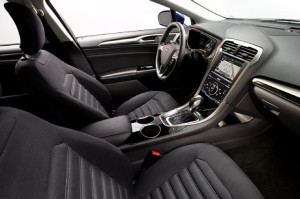
In any case, it’s a good-looking car. A sexy car, even. And – perhaps most important of all – it does not not look like a hybrid car. It is Spring Break – vs. Summer School. Jennifer Lawrence – vs. Mrs. Doubtfire.
But it is a less practical car.
Ford gave the Energi a very roomy front and second row – more roomy, in fact, than the first and second rows in the Prius. There’s 44.3 inches of first row legroom and 38.3 inches of second row legroom in the Energi – vs. 42.5 inches of first row legroom and just 36 inches of legroom in the second row of the Prius. But then you pop the Energi’s trunk and discover what amounts to a slightly larger-than-usual glovebox. A bit more than 8 cubic feet – which is 4 cubes less than in the regular Fusion hybrid and half the size of the standard (non-hybrid) Fusion’s 16 cubic foot trunk.
This would be marginal in a two-seater Miata – assuming the two people wanted to bring more than a small duffel bag with them. But in a four-door sedan – and assuming 4-5 people are going someplace – eight cubes is not going to cut it. Why is the trunk so tiny? Because the battery pack that’s been stuffed underneath the carpet is so big.
In contrast, the hatchback Prius has 21.6 cubic feet of space behind its second row – and can carry much more (and much more bulky/unwieldy) items with the second row folded and thanks to its taller roofed and hatchback layout.
Like a growing number of new cars, the Fusion Energi has a Star Trek Next Generation-style finger-tap “haptic” panel for the secondary controls (climate control, etc.) on the centerstack. No protruding knobs to turn or buttons to push. Easier to clean, too. But, the downside is you almost have to look before you tap anything – since you can’t go by feel anymore. And the haptic controls can be a little slow-reacting, too.
THE REST
The Energi comes with a unique set of gauges and displays, including real-time tutorials in “hypermiling” – driving in such a way as to maximize the efficiency of the hybrid drivetrain. If you’ve never driven a hybrid before, these will help you master the art. It’s also possible to monitor such things as kilowatts used, as well as MPGs. What’s less easy to keep track of is the cost to feed the thing electricity. You’d have to somehow separate out the increased demand on your monthly power bill, after having factored out ups and downs attributable to other things, like how much you ran the heat pump last month. 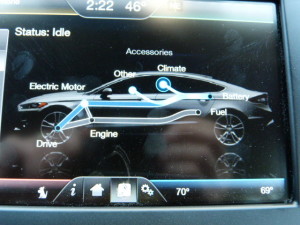
It would be helpful to know – exactly, objectively – what the annual cost would be to keep the Energi (or any plug-in) topped off. People complain about the cost of gas, but at least we now exactly how much a gallon of regular unleaded sells for – and how much we burn through in a week or month. The way kilowatt-hours (and so on) is reported is both inscrutable and highly variable. Anyone who has tried to parse their utility bill knows all about it.
From a technical point-of-view, plug-in hybrids are Buck Rogers amazing. Almost all the appealing attributes of a pure electric car (no more worries about the cost of gas) but without the hassles of owning an electric car (running out of juice; waiting for hours to recharge). But – to get back to the question originally posed – how come they aren’t selling nearly as well as conventional hybrids, despite all this?
Simple: The cost of the plug-in technology.
A plug-in Prius – even with the just-announced discount – still costs $6,000 more than the regular Prius. And the Fusion Energi starts out almost $13k higher than a standard (non hybrid) Fusion – and $5,000 more to start than a Fusion hybrid Titanium, comparably equipped (as far as luxury amenities).
That buys a lot of gas.
Don’t forget: The Fusion Energi’s MPG numbers – gas engine running – are lower than the regular Fusion hybrid’s. Buying the Energi over the regular Fusion hybrid might make economic/financial sense if your driving patterns allow you to run in EV mode (IC engine off) at least half the time. But even then, it would probably take several years to amortize the difference in up-front costs.
For me, the Energi makes no sense at all.
My daily drive starts out with 15 miles of steady-state running at highway speeds – which sucks a full charge to nil even faster than my ’76 Trans-Am 455 slurps down 93 octane at WOT. Literally. You’ve no doubt heard the saying: You can see the gas needle moving toward empty as you drive? That’s an exaggeration, even in the hungriest of muscle cars. But in a hybrid, it is a statement of fact. Anything faster than 50 or so MPH (or more than half pedal down) and you’ll see the LCD bar showing the battery pack’s state of charge wilt like a Popsicle in the microwave.
But for you, a plug-in could be a godsend. I have city-living friends whose daily commute is less than 5 miles – and rarely exceeds 35 MPH. They could realistically go from plug to plug and never (or almost never) burn a drop of gas.
The problem – for plug-ins generally – is that most Americans’ driving patterns are such that they end up relying too much on the dreaded IC engine to keep things moving along.
Too much to make the plug-in technology pay for itself, at any rate.
So, be very careful – and very honest with yourself. Don’t buy into the hype. I strongly recommend taking the Energi (or any plug-in you’re considering) for test drive along your everyday go-to-work route before you commit to buying. See how far you can drive on the batteries – and before the IC engine steps in. Calculate what your real-world mileage will be.
And then decide..
The Energi – like the plug-in Prius – could be a money saver. That’s debatable.
But unlike the Prius, the Energi is a good-looker. And a good-runner, too.
And that’s not debatable.
Throw it in the Woods?
PS: If you like what you see, consider supporting this site. We got dumped by Google – see here for the full story about that– and depend on you, the readers, to keep the lights on.
The link to our “donate” button is here. You can also mail stuff our way – if you prefer to avoid PayPal. The address is:
EPAutos
721 Hummingbird Lane, SE
Copper Hill, VA 24079


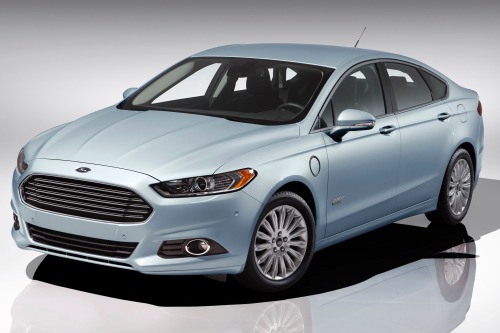


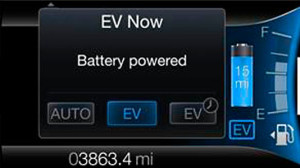
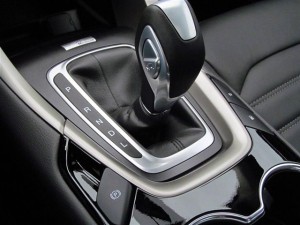










Fact is, a straight Prius, no plug-in feature, can pretty easily get 60-70 MPG on that five mile point-to-point commute. It’s the hills that take the fuel, that, and cruising highways at 55 plus. The other unavoidable energy hog is “warming up” the IC engine – but, once warmed up, it will happily let the batteries handle most of the work, and just the braking alone will often keep the overall energy use low enough to get 60 plus MPG around town – day in and day out.
It would be hard to justify paying that much more unless one were truly in love with the Ford’s styling and “non-hybrid” cachet. I drove a Fusion rental once when my Prius was out of action, and remember how much better the Prius felt when I got it back. Swap out the green weinie tires for some H -rated Michelins when the original set wears out, and the Prius out-handles the Ford, too, imo. And low twenties out the door – explains why I’m a fan.
I think that sums it up pretty well, DR.
The chief fly in the pie as regards the Fusion is its MSRP. If it cost about the same as the plug-Prius, I’d probably accept the less spectacular mileage as the price for the more engaging to drive car. But given the price disparity – and in view of the context (these cars are supposed to be about economy primarily) I, too, would go with the Prius.
You Cuck(old) Dynasty fellers doin’ all right? Still sitt’n front of the tube or puter in your Merican Henhouse incubating the next generation of safety heroes and compliance kamikazes for every Tomas, Ndiki, & Habib in the world?
Nothin better’n being an Uncle Tom/Sam Green Eggs and Pork ObamaDaddyDaycare hatchmaster in your Farmer Fanny Mae Battery Hen House now is there? Obey their rules of the rode and they won’t ride you too hard.
Yes you are being detained. no you are not free to go.
E Pluribus Estrus Unum.
Cocka Yankee Doodle Dandy Doo!
Smokey Yunick’s Hot Vapor 51 mpg Fiero
51 mpg Fiero 0-60 in less than 6 Seconds! See and hear it run.
http://www.legendarycollectorcars.com/featured-vehicles/other-feature-cars/smokey-yunicks-hot-vapor-fiero-51-mpg-and-0-60-in-less-than-6-seconds-see-and-hear-it-run-in-our-exclusive-video/
Smokey Yunick; Best Damn Garage in Town
http://www.legendarycollectorcars.com/featured-vehicles/other-feature-cars/smokey-yunicks-hot-vapor-fiero-51-mpg-and-0-60-in-less-than-6-seconds-see-and-hear-it-run-in-our-exclusive-video/smokey-yunick-the-legend-and-the-stories-best-damn-garage-in-town/
Sure does look like an Aston Martin.
Stuff like this always makes me wonder how good the tech will be in 5 yrs.
It almost costs as much, too!
The regular (non hybrid) Fusion is priced in the mid $20s. A loaded Energi plug-in costs almost twice that.
Why doesn’t anyone build a sub-$20k plug-in hybrid that can hit 70 MPG?
I know it’s possible.
Check out the Aerocivic, great read: http://www.aerocivic.com/
Notice the resemblance to a Citroen DS?
Your inexpensive 70mpg hybrid can be done, now – but not with body designs that haven’t changed all that much in 100 yrs..
261 mpg VW XL1 plug-in hybrid $145,000
http://www.nydailynews.com/autos/world-efficient-car-volkswagen-xl1-plug-in-hybrid-takes-streets-new-york-city-article-1.1545694
Volkswagen XL1 review
http://www.youtube.com/watch?v=m75t4UtX93c
Volkswagen XL1 Technology
http://www.youtube.com/watch?v=Ac99GgHbmzY
Remember the Honda Insight hybrid of the late ’90s? Two-seater configuration, very light and very fuel efficient. By far, the most fuel-efficient hybrid offered for sale thus far. It could average 60 MPG.
Converted to a plug in, this model could probably deliver 80 MPG or even better. Its light weight would enable it to run much farther on the batteries.
But it didn’t sell well.
Why? I think because most Americans pay lip service to gas mileage but really have other priorities. Which is fine – but it has resulted in dumb-ass vehicles like the Tesla and (to a lesser but still significant extent) the Fusion Energi. It’s not nearly economical enough (to drive) vs. what it costs to buy. One would probably do just as well buying a non-hybrid Fusion for $25k and putting the $15k you just saved toward fuel for the next five years.
There’s 9 of ’em up for bid on Ebay.
A crapload in DC for sale on Autotrader.
If you get the CVT you lose 14-20 mpg ’cause there’s no lean burn.
One of these would make an excellent project car. Update it to plug-in status. Or just lighten it up even more by selective replacement (and removal) of extraneous weight-adding components.
I remember test driving a new one back in the day. Fun little car that would have made a great commuter.
Way too expensive.
$41,700 in Vegas
http://www.gaudinford.com/inventory/new-vehicles#0/10/DisplayPrice/a//vehicleSet%3A299%20%20make%3D%22FORD%22%20model%3D%22FORD–FUSION%20ENERGI%22
$40,000 in Dee Cee
http://www.koonsfallschurchford.com/new-inventory/index.htm?listingConfigId=auto-new&year=&model=Fusion+Energi&trim=&internetPrice=&start=0&sort=&facetbrowse=true&searchLinkText=SEARCH&showInvTotals=false&showRadius=false&showReset=false&showSubmit=true&facetbrowseGridUnit=BLANK&showSelections=true&dependencies=city%3Aprovince%2Ccity%3Astate&suppressAllConditions=compliant
My test car sicked out over $44k!